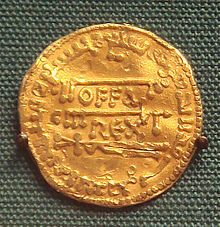Shortcoming
Mankuse or Mankus (lat. Mancus or mancusus) is the designation of a coin, a unit of account or a weight of gold in various uses in the early Middle Ages.
Use and origin

The use of the term mancus can be proven during the period from the end of the eighth to the end of the eleventh century and was used in the three meanings mentioned above in Italy and England, and later also in Spain. A letter from Leo III. to King Cenwulf from the year 797 mentions an annual payment of 365 Mankusen from King Offa to the Pope. One of these coins was found in Rome.
The value of a deficiency as a coin is equated with 30 silver denarii . As a gold weight, it corresponds to about 4.25 g.
The origin of the name mancus is the subject of controversial discussions. While Grierson sees the origin of the mancus in the Italian area and contrasts the solidus mancus as a kind of lightweight, i.e. deficient solidus with the full-fledged gold solidus , according to Welin the term is of Arabic origin, derived from manqūsh (منقوش, engrave, emboss).
swell
- RI Opac, in: Regesta Imperii RI Opac, II, 5 Papstregesten 911-1024, Ed. Zimmermann. 1998, URI: http://regesta-imperii.digitale-sammlungen.de/regest/ri02_ri_0915-04-00_000001_000001_002_005_001_000038_0000000034 (accessed on December 18, 2012)
literature
- Philip Grierson : The Myth of the Mancus , Revue belge de Philologie et d'Histoire, 1954, Vol. 32, pp. 1059-1074, Belgium, 1954
- Friedrich Frhr. v. Schrötter, N. Bauer (Ed.): Dictionary der Münzkunde , 2nd edition, Berlin, 1970, ISBN 978-3-11-001227-9
- Klaus Herbers : Leo IV. And the Papacy in the middle of the 9th century , Popes and Papacy, Volume 27. Stuttgart 1996, ISBN 3-7772-9601-5
- Ulla S. Linder-Welin: Some rare Samanid Dirhams and the Origin of the Word "Mancusus" , in Congresso internazionale de numismatica, Rome 1961 , Rome, 1965
- Harald Witthöft: Traces of Islamic influence in the development of Franconian coinage in the 8th century , in: Albert Zimmermann , Ingrid Craemer-Ruegengerg (ed.): Oriental Culture and European Middle Ages, Berlin, New York, 1985
- PWP Carlyon-Britton: The Gold Mancus of Offa, King of Mercia , URI: http://www.britnumsoc.org/publications/Digital%20BNJ/pdfs/1908_BNJ_5_5.pdf (accessed December 29, 2012)
- Julius Ficker : Research on the imperial and legal history of Italy , Volume 1, Innsbruck, 1868
Footnotes
- ↑ Medieval European Coinage By Philip Grierson, p.330
- ↑ Philip Grierson: The Myth of the Mancus , p. 1066 (8)
- ↑ Friedrich Frhr. v. Schrötter, N. Bauer (Ed.): Dictionary of Coin Studies , p. 366
- ↑ Philip Grierson: The Myth of the Mancus , p. 1066 (8)
- ↑ Friedrich Frhr. v. Schrötter, N. Bauer (Ed.): Dictionary of Coin Studies , p. 366
- ↑ Friedrich Frhr. v. Schrötter, N. Bauer (Ed.): Dictionary of Coin Studies , p. 366
- ↑ Harald Witthöft: Traces of Islamic Influence in the Development of Franconian Minting in the 8th Century , p. 411
- ↑ Philip Grierson: The Myth of the Mancus , p. 1072 (14)
- ↑ Ulla S. Linder-Welin: Some rare Samanid Dirhams and the Origin of the Word "Mancusus" , in Congresso internazionale de numismatica, Rome 1961 , II. 499-508